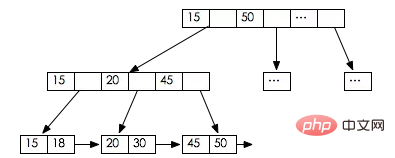The principle of MySQL index

MySQL database supports a variety of indexes, such as B-tree indexes, hash indexes, full-text indexes, etc. This article focuses on B-tree indexes. (Recommended: "mysql Tutorial")
Index principle & essence
MySQL official explanation: Index is data that improves the efficiency of data acquisition for MySQL. structure for fast querying of data. Indexes are data structures that satisfy a specific search algorithm, and these data structures point to data in a certain way to achieve efficient data search.
B tree
MySQL generally uses B tree as its index structure, so what are the characteristics of B tree?
If the tree degree is n, the upper limit of each node pointer is 2n 1
Non-leaf nodes do not store data, only pointer indexes; leaf nodes store all data, but do not store pointers
Based on the classic B-tree, a sequential access pointer is added. Each leaf node has a pointer to the next adjacent leaf node, as shown in the figure. Mainly to improve the performance of interval access. For example, if you want to find all the data with key 20 to 50, you only need to access all data nodes at once according to the sequential access route.

B-tree diagram with sequential access
Locality principle and disk read-ahead
So why Database systems generally use B-trees as index structures, instead of other structures such as red-black trees?
First of all, let’s introduce the principle of locality and the concept of disk read-ahead.
Generally speaking, the index itself is large and will not be stored entirely in memory. It will be stored on disk in the form of an index file. Therefore, disk IO operations will occur during the index search process, and disk IO is very slow compared to memory access, so the index structure should minimize the number of disk IO accesses.
In order to reduce disk IO, the disk often performs data pre-reading, starting from a certain position and pre-reading a certain length of data backwards into the memory, which is the principle of locality. Because disk sequential reading is more efficient and does not require seek time, it can improve IO efficiency.
The read-ahead length is generally an integer multiple of the page, and the main memory and disk exchange data in units of pages. When the data that needs to be read is not in the memory, a page fault interrupt is triggered. The system will send a request to the disk to read the disk data. The disk finds the starting position of the data and continuously reads one or several pages of data backwards and loads them into the memory. Then the interrupt returns and the system continues running. When designing a general database system, the size of the B-tree node is set to one page, so that loading of each node only requires one IO.
The above is the detailed content of The principle of MySQL index. For more information, please follow other related articles on the PHP Chinese website!

Hot AI Tools

Undresser.AI Undress
AI-powered app for creating realistic nude photos

AI Clothes Remover
Online AI tool for removing clothes from photos.

Undress AI Tool
Undress images for free

Clothoff.io
AI clothes remover

AI Hentai Generator
Generate AI Hentai for free.

Hot Article

Hot Tools

Notepad++7.3.1
Easy-to-use and free code editor

SublimeText3 Chinese version
Chinese version, very easy to use

Zend Studio 13.0.1
Powerful PHP integrated development environment

Dreamweaver CS6
Visual web development tools

SublimeText3 Mac version
God-level code editing software (SublimeText3)

Hot Topics
 1385
1385
 52
52
 Several situations of mysql index failure
Feb 21, 2024 pm 04:23 PM
Several situations of mysql index failure
Feb 21, 2024 pm 04:23 PM
Common situations: 1. Use functions or operations; 2. Implicit type conversion; 3. Use not equal to (!= or <>); 4. Use the LIKE operator and start with a wildcard; 5. OR conditions; 6. NULL Value; 7. Low index selectivity; 8. Leftmost prefix principle of composite index; 9. Optimizer decision; 10. FORCE INDEX and IGNORE INDEX.
 Under what circumstances will mysql index fail?
Aug 09, 2023 pm 03:38 PM
Under what circumstances will mysql index fail?
Aug 09, 2023 pm 03:38 PM
MySQL indexes will fail when querying without using index columns, mismatching data types, improper use of prefix indexes, using functions or expressions for querying, incorrect order of index columns, frequent data updates, and too many or too few indexes. . 1. Do not use index columns for queries. In order to avoid this situation, you should use appropriate index columns in the query; 2. Data types do not match. When designing the table structure, you should ensure that the index columns match the data types of the query; 3. , Improper use of prefix index, you can use prefix index.
 When might a full table scan be faster than using an index in MySQL?
Apr 09, 2025 am 12:05 AM
When might a full table scan be faster than using an index in MySQL?
Apr 09, 2025 am 12:05 AM
Full table scanning may be faster in MySQL than using indexes. Specific cases include: 1) the data volume is small; 2) when the query returns a large amount of data; 3) when the index column is not highly selective; 4) when the complex query. By analyzing query plans, optimizing indexes, avoiding over-index and regularly maintaining tables, you can make the best choices in practical applications.
 What are the classifications of mysql indexes?
Apr 22, 2024 pm 07:12 PM
What are the classifications of mysql indexes?
Apr 22, 2024 pm 07:12 PM
MySQL indexes are divided into the following types: 1. Ordinary index: matches value, range or prefix; 2. Unique index: ensures that the value is unique; 3. Primary key index: unique index of the primary key column; 4. Foreign key index: points to the primary key of another table ; 5. Full-text index: full-text search; 6. Hash index: equal match search; 7. Spatial index: geospatial search; 8. Composite index: search based on multiple columns.
 MySQL index left prefix matching rules
Feb 24, 2024 am 10:42 AM
MySQL index left prefix matching rules
Feb 24, 2024 am 10:42 AM
MySQL index leftmost principle principle and code examples In MySQL, indexing is one of the important means to improve query efficiency. Among them, the index leftmost principle is an important principle that we need to follow when using indexes to optimize queries. This article will introduce the principle of the leftmost principle of MySQL index and give some specific code examples. 1. The principle of index leftmost principle The index leftmost principle means that in an index, if the query condition is composed of multiple columns, then only the leftmost column in the index can be queried to fully satisfy the query conditions.
 Explain different types of MySQL indexes (B-Tree, Hash, Full-text, Spatial).
Apr 02, 2025 pm 07:05 PM
Explain different types of MySQL indexes (B-Tree, Hash, Full-text, Spatial).
Apr 02, 2025 pm 07:05 PM
MySQL supports four index types: B-Tree, Hash, Full-text, and Spatial. 1.B-Tree index is suitable for equal value search, range query and sorting. 2. Hash index is suitable for equal value searches, but does not support range query and sorting. 3. Full-text index is used for full-text search and is suitable for processing large amounts of text data. 4. Spatial index is used for geospatial data query and is suitable for GIS applications.
 How to use MySQL indexes rationally and optimize database performance? Design protocols that technical students need to know!
Sep 10, 2023 pm 03:16 PM
How to use MySQL indexes rationally and optimize database performance? Design protocols that technical students need to know!
Sep 10, 2023 pm 03:16 PM
How to use MySQL indexes rationally and optimize database performance? Design protocols that technical students need to know! Introduction: In today's Internet era, the amount of data continues to grow, and database performance optimization has become a very important topic. As one of the most popular relational databases, MySQL’s rational use of indexes is crucial to improving database performance. This article will introduce how to use MySQL indexes rationally, optimize database performance, and provide some design rules for technical students. 1. Why use indexes? An index is a data structure that uses
 Performance optimization strategies for data update and index maintenance of PHP and MySQL indexes and their impact on performance
Oct 15, 2023 pm 12:15 PM
Performance optimization strategies for data update and index maintenance of PHP and MySQL indexes and their impact on performance
Oct 15, 2023 pm 12:15 PM
Performance optimization strategies for data update and index maintenance of PHP and MySQL indexes and their impact on performance Summary: In the development of PHP and MySQL, indexes are an important tool for optimizing database query performance. This article will introduce the basic principles and usage of indexes, and explore the performance impact of indexes on data update and maintenance. At the same time, this article also provides some performance optimization strategies and specific code examples to help developers better understand and apply indexes. Basic principles and usage of indexes In MySQL, an index is a special number




